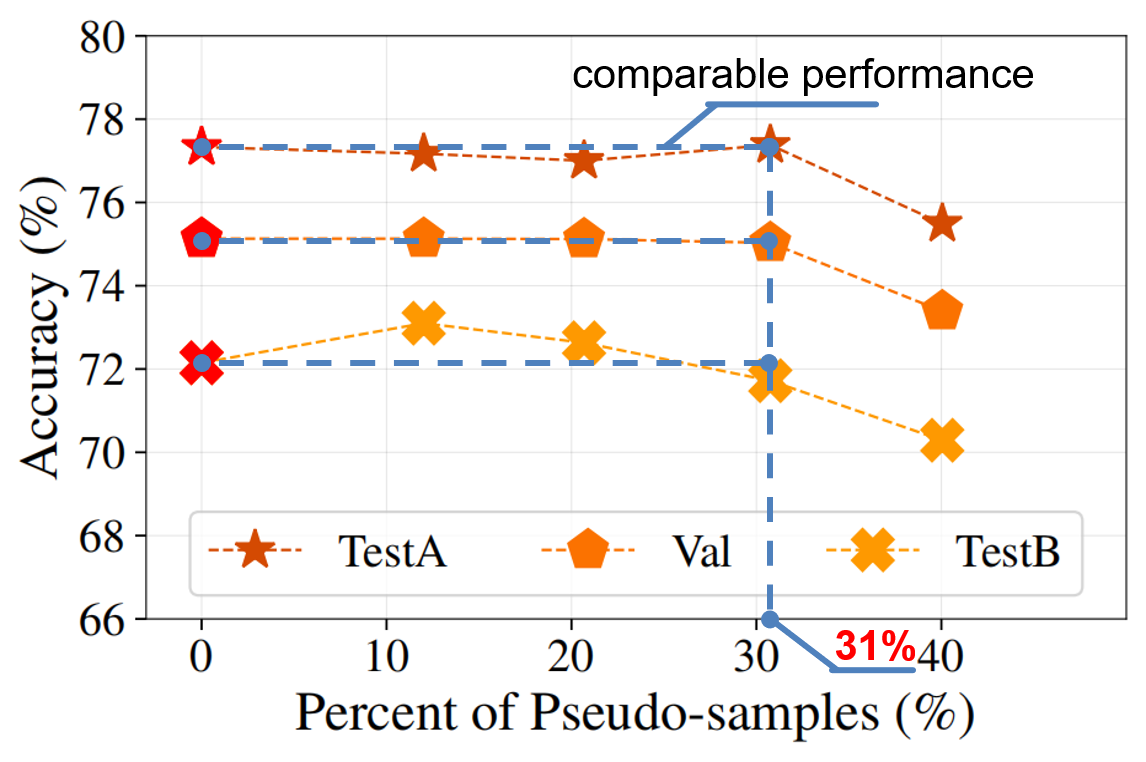This repository is the official Pytorch implementation for CVPR2022 paper Pseudo-Q: Generating Pseudo Language Queries for Visual Grounding. (Primary Contact: Haojun Jiang)
Please leave a STAR ⭐ if you like this project!
- Update on 2022/03/15: Release the training code.
- Update on 2022/06/02: Provide the poster and presentation video.
- Update on 2022/06/04: Release the pseudo-query generation code.
- Update on 2022/08/25: Provide the detection results for all datasets.
If you find our project useful in your research, please consider citing:
@inproceedings{jiang2022pseudoq,
title={Pseudo-Q: Generating Pseudo Language Queries for Visual Grounding},
author={Jiang, Haojun and Lin, Yuanze and Han, Dongchen and Song, Shiji and Huang, Gao},
booktitle={Proceedings of the IEEE Conference on Computer Vision and Pattern Recognition},
year={2022}
}
We present a novel method, named Pseudo-Q, to automatically generate pseudo language queries for supervised training. Our method leverages an off-the-shelf object detector to identify visual objects from unlabeled images, and then language queries for these objects are obtained in an unsupervised fashion with a pseudo-query generation module. Extensive experimental results demonstrate that our method has two notable benefits: (1) it can reduce human annotation costs significantly, e.g., 31% on RefCOCO without degrading original model's performance under the fully supervised setting, and (2) without bells and whistles, it achieves superior or comparable performance compared to state-of-the-art weakly-supervised visual grounding methods on all the five datasets we have experimented. For more details. please refer to our paper.
- Python 3.9.10
- PyTorch 1.9.0 + cu111 + cp39
- Pytorch-Bert 0.6.2
- Check requirements.txt for other dependencies.
1.You can download the images from the original source and place them in ./data/image_data folder:
- RefCOCO and ReferItGame
- Flickr30K Entities
Finally, the ./data/image_data folder will have the following structure:
|-- image_data
|-- data
|-- flickr
|-- gref
|-- gref_umd
|-- referit
|-- unc
|-- unc+
|-- Flickr30k
|-- flickr30k-images
|-- other
|-- images
|-- refcoco
|-- refcoco+
|-- refcocog
|-- referit
|-- images
|-- mask
|-- splits
./data/image_data/data/xxx/: Take the Flickr30K dataset as an example, ./data/image_data/data/flickr/ shoud contain files about the dataset's validation/test annotations(bbox-query pairs download from Gdrive) and our generated pseudo-annotations(pseudo-samples) for this dataset. You should uncompress the provided pseudo-sample files and put them on the corresponding folder../data/image_data/Flickr30k/flickr30k-images/: Image data for the Flickr30K dataset, please download from this link. Fill the form and download the images../data/image_data/other/images/: Image data for RefCOCO/RefCOCO+/RefCOCOg../data/image_data/referit/images/: Image data for ReferItGame.- Besides, I notice the links of refcoco/refcoco+/refcocog/referit data are not available recently. You can leave an email in Issues#2 and I will send you a download link.
./data/image_data/other/refcoco/, ./data/image_data/other/refcoco+/, ./data/image_data/other/refcocog/, ./data/image_data/referit/mask/, ./data/image_data/referit/splits/: I follow the TransVG to prepare the data and I find these folders actually are not used in training.
2.The generated pseudo region-query pairs can be download from Tsinghua Cloud or you can generate it follow instructions.
mkdir data
mv pseudo_samples.tar.gz ./data/
tar -zxvf pseudo_samples.tar.gz
Note that to train the model with pseudo samples for different dataset you should put the uncompressed pseudo sample files under the right folder ./data/image_data/data/xxx/. For example, put the flickr_train_pseudo.pth under ./data/image_data/data/flickr/.
For generating pseudo-samples, we adopt the pretrained detector and attribute classifier from the Bottom-Up and Top-Down Attention for Image Captioning and Visual Question Answering. The pytorch implementation of this paper is available at bottom-up-attention.
1.You can download the DETR checkpoints from Tsinghua Cloud. These checkpoints should be downloaded and move to the checkpoints directory.
mkdir checkpoints
mv detr_checkpoints.tar.gz ./checkpoints/
tar -zxvf checkpoints.tar.gz
2.Checkpoints that trained on our pseudo-samples can be downloaded from Tsinghua Cloud. You can evaluate the checkpoints following the instruction right below.
mv pseudoq_checkpoints.tar.gz ./checkpoints/
tar -zxvf pseudoq_checkpoints.tar.gz
-
Training on RefCOCO.
CUDA_VISIBLE_DEVICES=0,1,2,3,4,5,6,7 python -m torch.distributed.launch --nproc_per_node=8 --master_port 28888 --use_env train.py --num_workers 8 --epochs 10 --batch_size 32 --lr 0.00025 --lr_bert 0.000025 --lr_visu_cnn 0.000025 --lr_visu_tra 0.000025 --lr_scheduler cosine --aug_crop --aug_scale --aug_translate --backbone resnet50 --detr_model checkpoints/detr-r50-unc.pth --bert_enc_num 12 --detr_enc_num 6 --dataset unc --max_query_len 20 --data_root ./data/image_data --split_root ./data/pseudo_samples/ --prompt "find the region that corresponds to the description {pseudo_query}" --output_dir ./outputs/unc/;Notably, if you use a smaller batch size, you should also use a smaller learning rate. Original learning rate is set for batch size 256(8GPU x 32). Please refer to scripts/train.sh for training commands on other datasets.
-
Evaluation on RefCOCO.
CUDA_VISIBLE_DEVICES=0,1,2,3,4,5,6,7 python -m torch.distributed.launch --nproc_per_node=8 --master_port 28888 --use_env eval.py --num_workers 4 --batch_size 128 --backbone resnet50 --bert_enc_num 12 --detr_enc_num 6 --dataset unc --max_query_len 20 --data_root ./data/image_data --split_root ./data/pseudo_samples/ --eval_model ./checkpoints/unc_best_checkpoint.pth --eval_set testA --prompt "find the region that corresponds to the description {pseudo_query}" --output_dir ./outputs/unc/testA/;Please refer to scripts/eval.sh for evaluation commands on other splits or datasets.
1. Visualization of Pseudo-samples.
2. Experiments of Reducing the Manual Labeling Cost on RefCOCO.
3. Results on RefCOCO/RefCOCO+/RefCOCOg.
4. Results on ReferItGame/Flickr30K Entities.
Please refer to our paper for more details..
jhj20 at mails dot tsinghua dot edu dot cn
Any discussions or concerns are welcomed!
This codebase is built on TransVG, bottom-up-attention and Faster-R-CNN-with-model-pretrained-on-Visual-Genome. Please consider citing or starring these projects.




